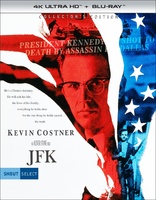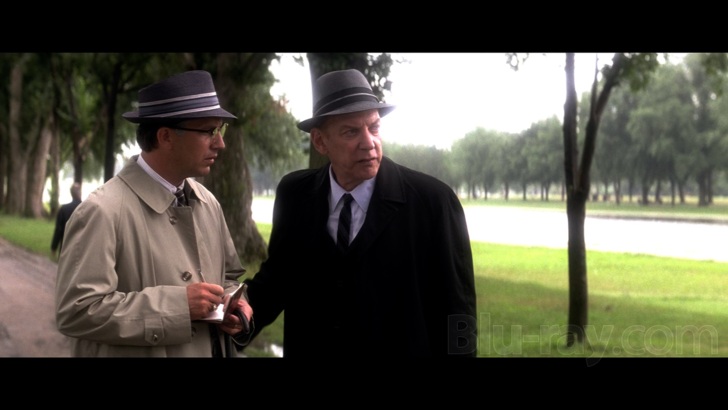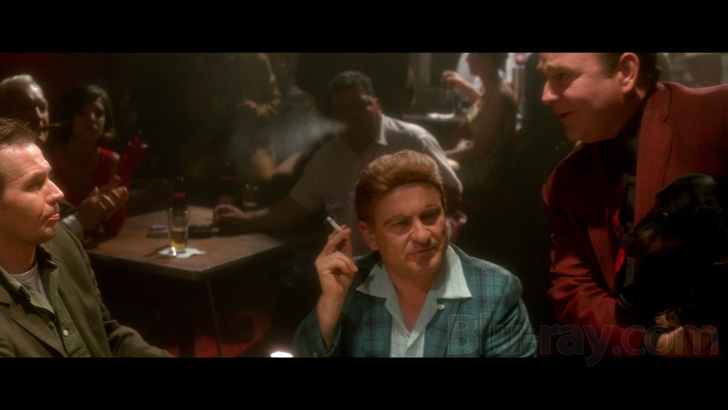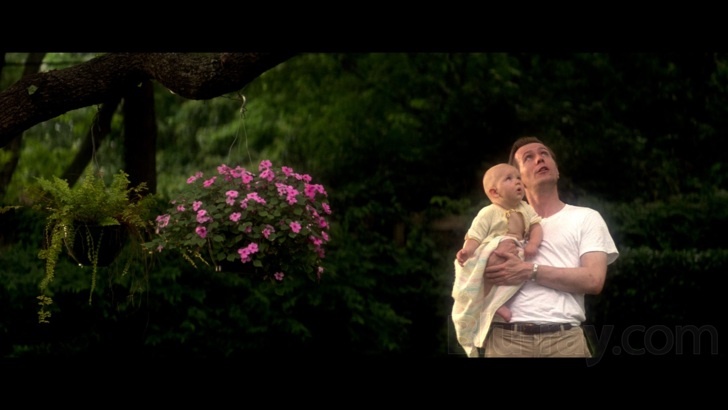JFK 4K Blu-ray Movie
HomeJFK 4K Blu-ray Movie 
Collector's Edition | Theatrical on BD / 4K Ultra HD + Blu-rayShout Factory | 1991 | 1 Movie, 2 Cuts | 206 min | Rated R | Dec 19, 2023

Movie rating
8.3 | / 10 |
Blu-ray rating
| Users | 4.8 | |
| Reviewer | 5.0 | |
| Overall | 4.8 |
Overview
JFK 4K (1991)
New Orleans District Attorney discovers there's more to the Kennedy assassination than the official story.
Starring: Kevin Costner, Kevin Bacon, Tommy Lee Jones, Laurie Metcalf, Gary OldmanNarrator: Martin Sheen
Director: Oliver Stone
| Drama | Uncertain |
| History | Uncertain |
| Crime | Uncertain |
| Period | Uncertain |
| Epic | Uncertain |
| Mystery | Uncertain |
| Thriller | Uncertain |
Specifications
Video
Video codec: HEVC / H.265
Video resolution: 4K (2160p)
Aspect ratio: 2.40:1
Original aspect ratio: 2.39:1
Audio
English: DTS-HD Master Audio 5.1 (48kHz, 24-bit)
English: DTS-HD Master Audio 2.0 (48kHz, 24-bit)
Subtitles
English SDH
Discs
Blu-ray Disc
Four-disc set (4 BDs)
4K Ultra HD
Playback
Region A (locked)
Review
Rating summary
| Movie | 5.0 | |
| Video | 4.5 | |
| Audio | 5.0 | |
| Extras | 4.0 | |
| Overall | 5.0 |
JFK 4K Blu-ray Movie Review
Reviewed by Dr. Stephen Larson January 6, 2024In the pre-Internet era, few films in cinema history received the volumes of articles written about it than JFK did in 1991–92. The furor actually began many months before the movie's December '91 release. In the early spring of that year, Washington Post reporter George Lardner received a first draft of Oliver Stone's 150-page screenplay from JFK assassination historian Harold Weisberg and wrote a lengthy article alleging gross inaccuracies in it. Stone and his co-writer Zachary Sklar wrote letters to the editors of various newspapers and magazines defending their positions on the assassination and President Kennedy's policies. The back-and-forth between JFK's scribes and journalists (primarily in the mainstream media) went on through the film's premiere and beyond it. It wasn't just proponents of the lone-assassin myth who attacked the filmmaker's views on the case. There also was large controversy about Stone and Sklar adapting former New Orleans District Attorney Jim Garrison's third book, On the Trail of Assassins (1988). A groundswell of criticism surrounding that decision was leveled at Stone by pro-conspiracy writers and authors such as Weisberg, Robert Sam Anson, Jonathan Kwitny, and David Lifton. Garrison's critics disagreed vigorously with how he handled his investigative probe. Stone's choice to adapt his book on the case caused a major uproar. I believe that while Stone's objective of making JFK was to present credible evidence to a mass audience that a conspiracy brought down the 35th president, an indirect (if inadvertent aim) was to rehabilitate Garrison's image. Although Garrison was exonerated in court for allegedly accepting bribes to protect pinball gambling, he lost his bid for reelection as DA in 1973. Garrison understandably stayed out of the public spotlight, declining interviews for the rest of that decade and much of the 1980s until the publication of OtTotA.

Since Garrison is the only public official to lead a prosecution into the death of President Kennedy, Stone uses DA Garrison (Kevin Costner) as a vessel to investigate the scene of the crime in Dallas as well as the mysterious activities of New Orleans businessman Clay Shaw (Tommy Lee Jones), former Eastern Airlines pilot David Ferrie (Joe Pesci), and accused assassin Lee Harvey Oswald (Gary Oldman) prior to JFK's murder. Stone's critics have wrongly proclaimed that he flagrantly mixes facts with theories to mislead viewers. The film shows the Warren Commission's version of Oswald firing at the president's limousine and a reenactment of him shooting Dallas Police officer J.D. Tippit (Price Carson). The WC's official record is contrasted with the perspectives of various eyewitnesses such as Lee Bowers (Pruitt Taylor Vince), Jean Hill (Ellen McElduff), and Sam Holland (James N. Harrell). The film is much more balanced than it has been credited for since its initial release. JFK should be regarded as both an explorative inquiry into Kennedy's murder and a presentation of historical possibilities from the period that it depicts.
JFK 4K Blu-ray Movie, Video Quality 

Shout Select's four-disc "Collector's Edition" comes with three black cases housed in a hard and sturdy slipbox. (The cases fit in the box so snug it's hard to pull any one out.) The 4K UHD BD-100 (actually 90 GB) contains the 205-minute Director's Cut (DC). This transfer is sourced from a director-approved scan of the original camera negative and presented in Dolby Vision (HDR10 compatible). This release is a milestone because it's the first time the 189-minute Theatrical Cut (TC) has been on Blu-ray. Warner Bros. put the TC out on VHS and a letterboxed LD in May 1992. WB re-used the non-anamorphic transfer on its European DVDs, beginning ca. 1999 in France. I have a Warner/Fox PAL DVD of the TC that was pressed in 2012. I have interleaved frame grabs of it with other transfers in the Screenshots tab. (Oddly, the TC was never issued on R1 DVD.) Like Shout's Natural Born Killers set, the TC is only presented with a 1080p transfer.
Before going into details about the Shout and WB/Fox transfers, it's important to discuss first the shooting formats and film stocks of JFK. I will be referring to a wonderful article Bob Fisher wrote on JFK in the February 1992 issue of American Cinematographer. Fisher interviewed cinematographer Robert Richardson, who showed AC a diary he kept of JFK's shoot. Almost all of the original footage was shot in 2.39:1. The scene of the assassination (shot in B&W) at the beginning of the film appears in 1.85:1 non-anamorphic. When there's a time cut to cherry blossoms and New Orleans on 11/22/63, the screen ratio shifts to 2.39:1 anamorphic. According to Fisher, Richardson and his crew used seven cameras and 14 film stocks for the full shoot. For the Dealey Plaza sequence, Richardson had two 35 mm Panaflex cameras operating at the same time. In addition, five 16 mm cameras and a Super 8 camera were present. Altogether, there were 70 to 80 shots in 35 mm black & white. Hundreds of 16 mm shots are incorporated into the film. JFK integrates several "home movies" that Dallas spectators captured of JFK's motorcade. Richardson duplicated and enhanced the images in 35 mm, 16 mm and Super 8 formats. He combined several to recreate the assassination. Fisher notes that for some scenes, original newsfilm footage is integrated, augmented, and matched with new video in Super 8 and 16 mm formats. Stone's DP also utilized an Eastman EXR 7248 film (a 100-speed fine-grain negative) for some 16 mm shots. An astounding 2000 opticals were needed, mainly for blow-ups from the smaller formats to 35 mm intermediate footage. The scene in the Dallas parking garage was shot on 16 mm newsfilm and live video. Richardson shot some sequences on Kodachrome and Kodacolor film, each of which displays a dense and contrasty image. Richardson discovered that the Kodachrome Super 8 blow-ups were quite grainy. This appearance is apparent in all of the transfers I've seen of JFK.
Richardson shot on Eastman EXR 5248 film because he wanted to give day and night scenes a "cleaner look" (as he put it to Fisher in the article). A clearer image is apparent in many of the shots in the Garrison family home. Several films that Richardson has shot have incorporated accented or attached lighting. For example, an actor such as Brian Doyle-Murray in JFK is lit from above. In a color 35 mm scene with Oswald and others in a group shot, Richardson explains what he did to Fisher: "Everything in the room played off one table. We took a series of HMI PARS directly overhead and we bounced the keylight off the table. Then we had a low, hard light come through the near window. That's our edge light. The faces ranged in exposure from 2/3 overexposed (Oswald), to a stop and 1/2 under for those furthest from the table." For other scenes in B & W, a number of the recreated images show light extending out from the actors' heads, arms, and legs when they are photographed in profile. (I didn't have enough image placeholders in the review template to supply all these examples, which you'll hopefully notice in your next viewing.) For a boardroom scene with Garrison and his investigative team, Richardson situated what he calls a "glowing tabletop" (see Screenshot #11).
I tested Shout's 2160p transfer extensively with HDR. The gamma levels are as high and well-pronounced as any transfer of JFK that I've seen. Color delineation and hue detail are phenomenal. For the color footage that Richardson and his crew shot, only a few tiny white specks pop up. I played the Shout Blu-rays of the DC and TC in their native 1080p presentations and also upscaled them to 4K on my Panasonic UHD. While I do notice an uptick in detail with the upscaling, primary colors do not stand out as much as they do when viewed with Dolby Vision and HDR10.
On the Fox BD and Shout's BD/UHD transfers (screen capture #s 34-37), you'll notice a liquid stain at the top right of Dean Andrews (John Candy). This my have happened when the film was originally developed or possibly due to handling. I did not notice this blemish, however, on the TC DVD but I could have missed the exact frame because of the PAL disc's 4 percent speedup. Grain is stable on the 35 mm color shots. For the archival black & white footage, grain is heavily prominent. For certain black & white shots lensed by Richardson, such as the one (frame grab #2) with Oswald holding a Coca Cola bottle, grain isn't as conspicuous.
The 2008 WB DigiBook and 2013 WB 50th Anniversary Ultimate Collector's Edition employed an identical 2K transfer (using a VC-1 encode) that averaged a rough average video bitrate of 18849 kbps on the Director's Cut. From a technical standpoint, the 2012 Warner/Fox UK BD was a modest upgrade. It used the MPEG-4 encode instead but it's essentially the same transfer. The TC on the BD-50 has a standard video bitrate of 26470 kbps while the DC averages about 23402 kbps. The 4K UHD surges past them: it boasts a mean video bitrate of 53300 kbps and an overall bitrate of 62700 kbps.
Screenshot #s 1-20, 24, 28, 32, 36, & 40 = Shout Select 2023 4K UHD, Director's Cut BD-100 (downsampled to 1080p)
Screenshot #s 21, 25, 29, 33, & 37 = Warner Home Video/Fox UK DVDs, Theatrical Cut
Screenshot #s 22, 26, 30, 34, & 38 = Fox UK 2013 Blu-ray
Screenshot #s 23, 27, 31, 35, & 39 = Shout Select 2023 Blu-rays (BD-50s)
Both the 188-minute and 205-minute cuts receive twelve scene selections on the Shout discs. The Warner/Fox BD provides a whopping 88 chapters.
JFK 4K Blu-ray Movie, Audio Quality 

Shout has supplied a DTS-HD Master Audio 5.1 Surround remix and the film's original 2.0 Stereo mix. The WB BDs only have a Dolby TrueHD 5.1 track (1611 kbps, 16-bit). The Fox UK BD has a more robust rendering of the 5.1. That disc uses a DTS-HD MA codec and averages 4144 kbps at 24 bits, but it lacks a stereo option. In fact, no BD globally has included an English stereo track till this release. On DVD, the European SD discs have 2.0 for the Theatrical Cut, while Warner's 1997 disc has it for the Director's Cut. The Shout discs' rendering of the original Dolby Stereo SR do an excellent job of separating John Williams's score between the front channels and surrounds. It sounds like an authentic matrixed stereo surround mix. Audio info from the score isn't necessarily duplicated from front to back. Rather, the instruments are sometimes discretely heard and spread between the channel areas. For example, strings along the front are counterpointed by some brass on the satellite speakers. Both lossless mixes on the Shout discs deliver Williams's music with aplomb. The composer applies a theme-and-variation method for the "Theme from JFK." Williams sometimes performs it solo on piano. Other times, Tim Morrison's trumpet solo augments the background accompaniment. The main theme also makes an appearance for the "Drummers' Salute" where it's heard underneath drum taps by The Royal Scots Dragoon Guards. The drums sound ultra-clear on the uncompressed mixes. "The Conspirators," a secondary theme by Williams, has what sound like taps on a wood block. It's Williams's most complex piece for this score, mixing in dark strings, other woodwinds, brass, and a few electronic sounds. The score sounds grand on both mixes.
Much of JFK's dialogue is comprised of Southern accents, authentic or adopted by the film's huge cast. Spoken words register clearly along the fronts. When an eyewitness is interrogated by an FBI special agent, the latter's rebutting words, "You heard echoes. Echoes!" are so clear that I felt I was in the room with them. On the 5.1, I could hear a blast on the SR speaker when stock footage shows a long, canon-like weapon fired by a guerrilla fighter in Cuba. Gunshots have a pretty loud and piercing sound.
On the Shout Blu-rays, the TC has a rough average audio bitrate of 3859 kbps (24-bit) for the 5.1 while the 2.0 Stereo averages 2010 kbps (24-bit).
The 5.1 on the DC (4119 kbps, 24-bit) is similar to Fox's mix. The stereo option averages 2025 kbps (24-bit). The mean audio bitrates on the 4K UHD are identical to those on the DC's BD-50.
The optional English SDH give a complete transcription of the delivered words. I only noticed one or two typos.
JFK 4K Blu-ray Movie, Special Features and Extras 

Shout has recorded six recent interviews with JFK crew members. Each are pretty brief. Shout has also ported over most of the bonus materials that have been available on various DVDs and BDs. The major absence is Barbara Kopple and Danny Schechter's documentary, Beyond 'JFK': The Question of Conspiracy (1992). This first appeared on Pioneer's "Special Limited Edition" LD box set in '93. It also was included on a majority of DVDs and BDs that featured the Director's Cut. You will want to hang on to at least one of those. The Fox BD has subtitles in English and several other languages for all the extras except for the commentary track and trailer.
DISC ONE: 4K ULTRA HD — DIRECTOR'S CUT (3:25:30, 2160p)
- Audio Commentary with Director, Producer, & Co-Writer Oliver Stone - this feature-length commentary track was first included on the 2001 Warner Home Video DVD of JFK. Stone covers a great many topics throughout. Definitely worth at least one listen. In English, not subtitled.
DISC TWO: BLU-RAY — DIRECTOR'S CUT (3:25:30, 1080p)
- Audio Commentary with Director, Producer, & Co-Writer Oliver Stone - this feature-length commentary track was first included on the 2001 Warner Home Video DVD of JFK. Stone covers a great many topics throughout. Definitely worth at least one listen. In English, not subtitled.
DISC THREE: BLU-RAY — THEATRICAL CUT (3:08:42, 1080p)
- Audio Commentary with Director, Producer, & Co-Writer Oliver Stone - this is very much the same commentary track that's on the DC. Only difference is it has been edited to match the 188 minutes of the TC. In English, not subtitled.
DISC FOUR: SPECIAL FEATURES
- NEW One Person Can Make a Difference – Oliver Stone on JFK (8:29, 1080p) - in this recent interview, Stone looks back at the legacy of JFK, how it affected his career, the JFK Records Act, the Assassination Records Review Board (ARRB), and his views of President Kennedy. In English, not subtitled.
- NEW Stone Bold – Cinematographer Robert Richardson on JFK (7:18, 1080p) - Richardson talks about the communication methods he shares with Stone on their various films, how and what he learned about JFK's assassination, his impressions of the Zapruder Film, and cinematographic formats and processes for JFK. In English, not subtitled.
- NEW Brave New Worlds – Editor Hank Corwin on JFK (9:29, 1080p) - Corwin spends the first part of the interview talking about working with Robert Richardson early in his career, meeting Stone during post-production of The Doors (1991), and working on U-Turn (1997). In the second part, he very briefly describes what he found at the UCLA Film & Television Archive for inclusion in JFK, among other subtopics. In English, not subtitled.
- NEW Supporting the Vision – Co-Producer Clayton Townsend on JFK (8:33, 1080p) - Townsend remembers meeting Stone during the making of Year of the Dragon (1985) and discusses some of their subsequent collaborations. He details some of the research for the JFK production and a trip with Stone to interview Dallas eyewitnesses. Townsend also shares stories about the location shoot, including lending a helping hand at the TSBD. In English, not subtitled.
- NEW Re-Creating the Unthinkable – Special Makeup Effects Artist Gordon J. Smith on JFK (7:44, 1080p) - Smith explains the big challenge of recreating JFK's body in Parkland Hospital, his research, and a realist sculptor he hired. Smith also shares some great stories. In English, not subtitled.
- NEW The Delicate Hands of Time – Dallas Location Manager Patty Doherty Hesson on JFK (9:50, 1080p) - Hesson describes the logistical challenges of filming in Dealey Plaza. She tells of a frantic call she received from Richardson before filming some big scenes there. In English, not subtitled.
- Deleted/Extended Scenes and Alternate Ending (54:46, upconverted to 1080p) - twelve excised and extended scenes. Each is prefaced with a description from Stone and Sklar's screenplay. All are shown in 2.39:1. A few are displayed in the non-anamorphic Scope ratio. Most of the scenes appear horizontally stretched. There is a timestamp on each scene. Scenes can be viewed with or without commentary from Stone. In English, not subtitled.
- Assassination Update - The New Documents (29:40, upconverted to 1080i) - this multimedia presentation narrated by Jim DiEugenio first appeared on the 2001 DVD of JFK, which is part of the 10-disc Oliver Stone Collection. DiEugenio offers a very cogent summary of the disclosures the declassified files revealed in the '90s by the ARRB. He connects the findings from these documents with persons and events featured in JFK. In English, not subtitled.
- Meet Mr. X: The Personality and Thoughts of Fletcher Prouty (11:00, upconverted to 1080i) - another holdover from the 2001 DVD that later reappeared on the BD editions. It was shot on videotape in the early '90s. I believe the interviewer is author Vince Palamara, a JFK Secret Service expert. In English, not subtitled.
- NEW Still Gallery (3:22, 1080p) - this slide show comprises thirty-nine images, which are mostly of the JFK production. They include on-set photographs and a few at the end which show the one-sheet poster.
- Theatrical Trailer (2:22, upconverted to 1080i) - Warners' official trailer for JFK presented in (cropped) 1.78:1 anamorphic widescreen. While the trailer is in decent shape, it hasn't been restored as it displays some film artifacts. Accompanied by Dolby Digital 2.0 Stereo (192 kbps).
JFK 4K Blu-ray Movie, Overall Score and Recommendation 

JFK is one of the very best, not to mention most important, historical dramas Hollywood has ever made. No matter how many times I have watched the extended sequence where Garrison meets with Mr. X (Donald Sutherland) in Washington, it always seems I absorb a new detail. The long-term implications that JFK's murder have had on policies at home, relations with Cuba and Russia, and the Johnson administration's revised policies in Southeast Asia continue to stick with me. Shout Select's 4K presentation of the Director's Cut is eye-popping. Colors are unmanipulated from how the picture originally looked dating back to the LD. The digital grade is first-rate. While it would have been a treat to also get the theatrical version on UHD, I am glad it's at last given a 1080p transfer (though it's been available before on Prime in HD). Both lossless audio tracks sound excellent. This is the first time the original stereo has been available on Blu-ray anywhere! The half-dozen new interviews are rather brief but pretty informative. I am hoping that WB finally gets around to putting David Miller's lesser known Executive Action (1973) on Blu-ray. MY HIGHEST RECOMMENDATION for this four-disc set.
Other editions
JFK: Other Editions

JFK
Director's Cut
1991

JFK
Director's Cut
1991

JFK
Director's Cut
1991

JFK
50th Anniversary Ultimate Collector's Edition
1991

JFK 4K
Director's Cut
1991
Similar titles
Similar titles you might also like

All the President's Men
Two-Disc Special Edition | featuring All the President's Men Revisited
1976

The Pelican Brief
1993

State of Play
2009

Zodiac 4K
Theatrical 4K | Director's Cut BD only
2007

Missing
1982

The Untouchables 4K
35th Anniversary Edition
1987

J. Edgar
2011

The Ghost Writer
2010

A Few Good Men 4K
25th Anniversary Edition
1992

Changeling
Academy Awards O-Sleeve
2008

Syriana
2005

The Long Good Friday 4K
1980

Bridge of Spies
2015

The Borgias: The Complete Series
2011-2013

Devil in a Blue Dress 4K
1995

Good Night, and Good Luck.
2005

Anatomy of a Murder
1959

Magic City: The Complete First Season
2012

A Most Violent Year
2014

Foyle's War: Set 8
2014